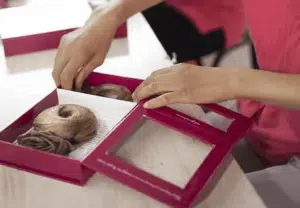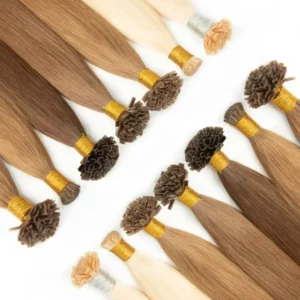You need rows that disappear in the hair, sit flat, and move naturally. You also need fast installs, precise customization, and zero scalp irritation. Genius weft hair extensions were built to solve exactly that.
Genius wefts are ultra-thin, cuttable anywhere, and made with no “return hair.” They blend like hand-tied, build like machine wefts, and size perfectly on-head without shedding. For luxury salons that want invisible rows and repeatable results, this is the new standard.
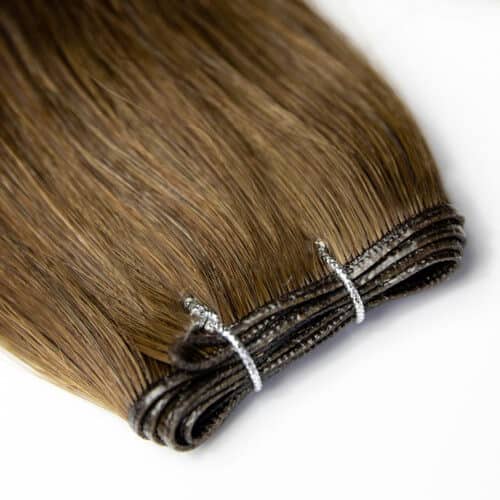
You will find a manufacturer-level breakdown: what a genius weft is, how it compares to hand-tied and machine wefts, the exact install flow with beaded rows, core aftercare, service timing, SKUs, and quality control. Use this as your chair-side playbook.
What are genius weft hair extensions?
You want the look of hand-tied with freedom to cut and customize. You also want comfort for sensitive scalps. That is the idea behind the genius weft.
A genius weft is an ultra-thin, sealed-top weft that you can trim anywhere without shedding. It has no return hair. It lies flat under beaded rows and stays comfortable through daily wear and move-ups.

Genius weft construction fixes three pain points at once: bulk, inflexibility, and irritation. Legacy machine wefts carry a thicker stitch and a “mustache” of return hair that can scratch. Hand-tied wefts feel thin and look invisible, but you cannot cut them without unraveling. Genius wefts use a low-profile composite stitch that seals the top and eliminates return hair. This sealed edge lets you trim to any width on the head map, from 1–2 cm micro-fillers at the temple to full-width panels at the occipital. The profile is typically ~0.7–0.9 mm thin, so the row sits close to the scalp with less printing through fine hair. On full cuticle, single-donor hair, the aligned cuticles reduce friction between strands, which lowers tangle risk and preserves shine. For stylists this means faster fitting, cleaner blending, and higher yield per bundle. For owners it means fewer redo’s, stronger retail photos, and better client retention. For clients it means softer bases, easier ponytails, and a “nothing there” feel in the first week, which is when comfort problems usually show. Pair the top with proper thread, lined micro-beads, and measured tension, and you get repeatable rows that pass both the comb test and the high-pony test.
Pros and cons of genius weft hair extensions?
You want the advantage list and the guardrails in one place. Here it is without fluff.
Genius wefts deliver ultra-flat comfort, cut-anywhere flexibility, and lower waste. You manage stitch discipline, sourcing quality, and home care to protect the thin top and the sealed edge.
Key pros
- Ultra-flat band for clean partings, crowns, and updos.
- No return hair, so less itch and less friction at the base.
- Cuttable anywhere with no shed, which speeds installs and reduces waste.
- Smart density control: stack narrow strips where you need power; micro-veil where you need a soft edge.
- Premium finish on full cuticle hair for better shine, tone stability, and lifespan.
Key cons
- Higher material cost than standard machine wefts.
- Technique matters: big needles, harsh tension, or piercing the sealed edge can mark the top.
- Market copies exist; poor sealing can delaminate on cuts.
- Client care must be consistent: base drying, gentle detangling, and timely move-ups.
Risk controls
- Use fine nylon or polyester thread, size 28–32 curved needles, and lined silicone micro-beads.
- Keep stitch placement just below the sealed edge, not through it.
- Source SKUs with cut-testing certifications and fiber origin proof.
- Educate clients with a written card and a two-week check call or message.
Quick reference
| Dimension | Recommended |
|---|---|
| Band thickness | ~0.7–0.9 mm |
| Typical row beads spacing | 1.0–1.5 cm |
| Stitch interval | 0.8–1.2 cm |
| Move-up window | 6–8 weeks |
| Daily brushing | 2× (AM/PM) |
Genius weft vs hand-tied?
You love the invisibility of hand-tied. You do not love fixed widths and “do not cut.” Compare them side by side.
Genius keeps the hand-tied look but removes the no-cut rule. You get thin, soft rows with full freedom to size pieces on-head, which lowers waste and speeds work.
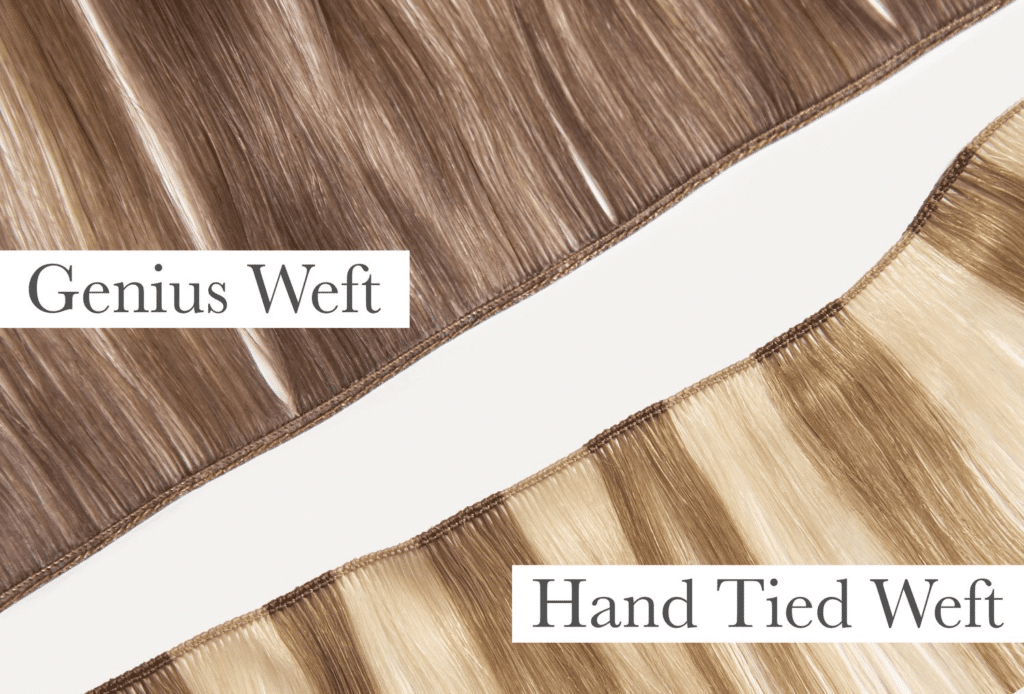
1
1
Profile and feel
Both options sit flat. Genius edges ahead on comfort for sensitive scalps because there is no return hair rubbing at the base. In heat-sweat conditions and helmets, that difference is obvious.
Customization and yield
Hand-tied widths are fixed, so you fold, stack, and plan more carefully. Cutting risks unraveling, which creates stress at the corner and wastes hair. Genius lets you trim to the head map in seconds. That raises yield per bundle and makes temple arcs, crown veils, and face frames precise.
Speed and rework
Genius reduces “width guessing” and corner folding, so first installs go faster and move-ups have fewer micro-adjustments. Fewer seam bulges means fewer redo calls after clients try a high pony.
Durability
Well-made hand-tied lasts when handled carefully. Well-made genius lasts as long or longer because the corners remain sealed after trimming. The weak link on both is technique: over-tight beads, piercing the edge, or heavy tension at curves. Keep tension even, and both survive many cycles.
Use cases
| Scenario | Choose |
|---|---|
| Ultra-invisible row + custom widths | Genius |
| Set method, no cutting needed | Hand-tied |
| Clients with scalp sensitivity | Genius |
| Budget to mid premium | Hand-tied or Machine |
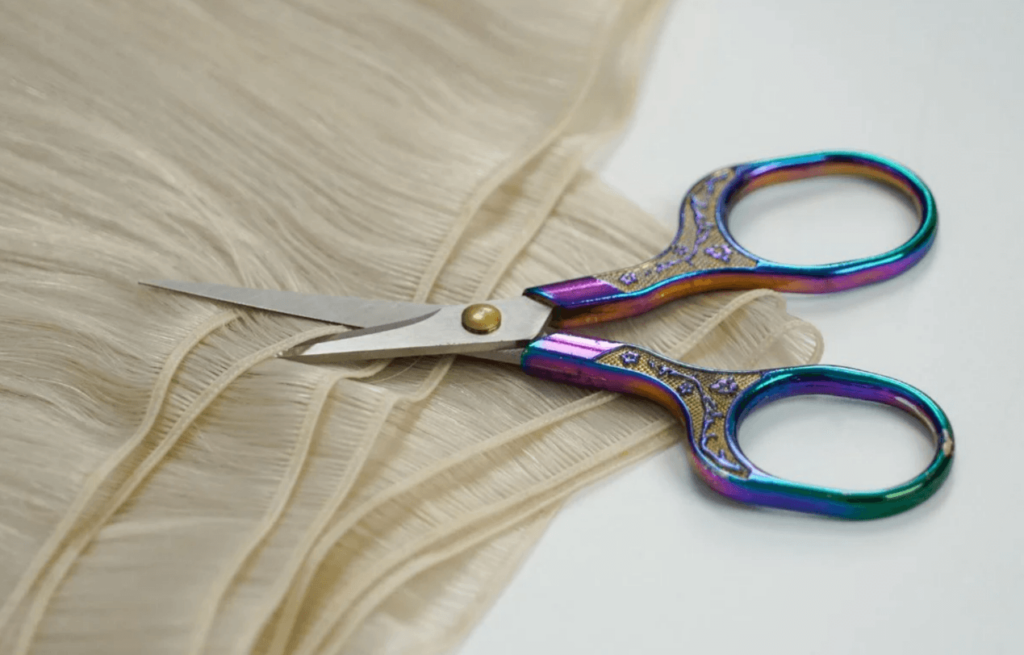
Genius weft vs machine weft?
Machine wefts are rugged and cost-efficient. The top is thicker and has return hair. Genius aims at luxury finish and comfort.
Genius delivers the flatness, comfort, and cut freedom machine wefts lack, while keeping strong stitch integrity. Machine still wins on tight budgets and heavy-density builds where bulk is acceptable.
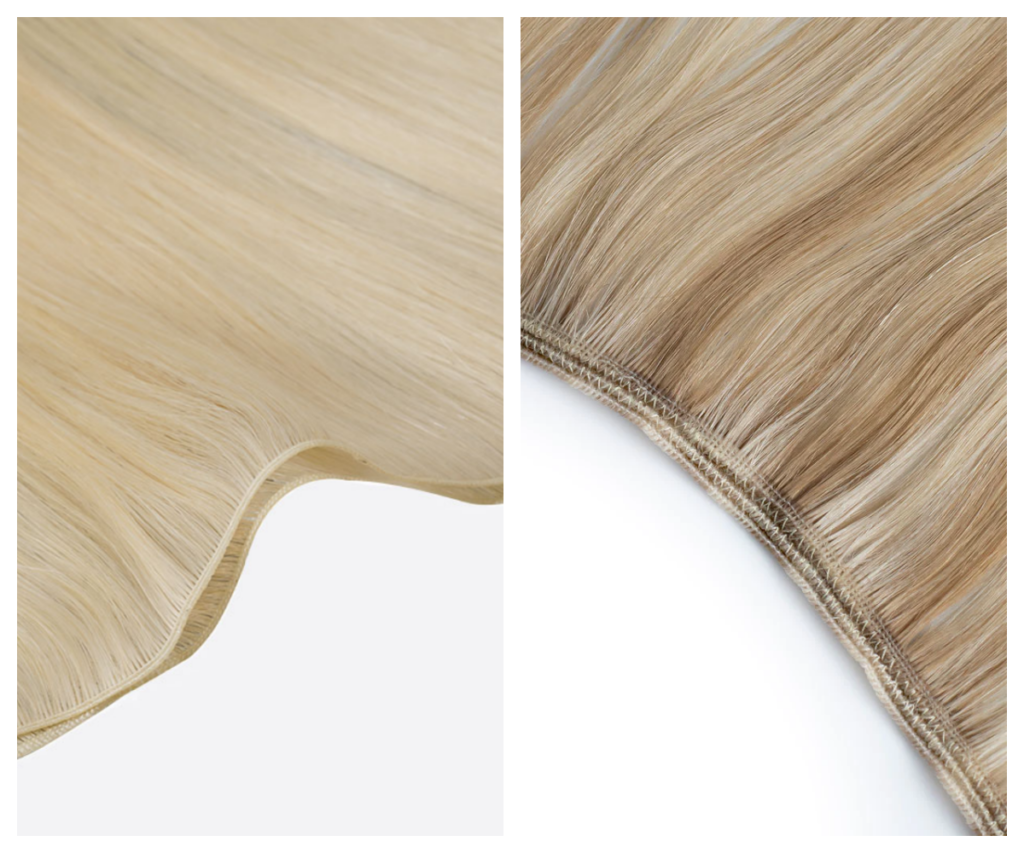
Top profile
Machine wefts print more under fine hair and at updos because of the bulkier stitch and return hair. Genius keeps a slim line that disappears under light partings.
Cut behavior
Machine wefts can shed at the cut if edges are not sealed post-trim. Genius wefts are engineered to be cut anywhere without sealing steps. That changes speed and confidence on the head.
Comfort
Return hair on machine wefts can itch in week one. Genius removes the source. That lowers complaint tickets and improves day-one satisfaction.
Cost and throughput
Machine wefts cost less and remain popular for high-density looks. Genius costs more but lowers waste and chair time, which can offset material price at salon scale.
Decision grid
| Factor | Machine Weft | Genius Weft |
|---|---|---|
| Band thickness | Thicker | Ultra-thin |
| Return hair | Present | None |
| Cut anywhere w/o shed | Depends | Yes |
| Comfort | Medium | High |
| Best fit | Budget density | Luxury invisible rows |
How to install genius weft hair extensions?
You want a clear method that protects the sealed edge and gives speed. This beaded-row flow works across most heads.
Map 2–4 rows, lay a clean bead track, size the weft on-head, and lock with fine stitches below the sealed edge. Keep tension even. Finish with balanced weight per row and a simple blend.
Tools
Lined micro-beads (2.5–3.0 mm), pulling loop, fine nylon/poly thread, size 28–32 curved needle, sectioning clips, mini shears, soft brush, heat protectant, tail comb, spray bottle.
Prep
Clarify if needed. Dry smooth. Map rows with 1.5–2 cm buffer from hairline and part. Keep 2–3 cm above nape baseline. Note whorls and low-density zones.
Anchor track
Part a gentle arc that mirrors the skull. Place beads 1.0–1.5 cm apart with uniform elevation. Test comfort. If scalp is tender, widen spacing slightly.
Size on-head
Hold the genius weft to the arc. Mark ends. Trim to exact width. Cut micro-strips for temples and crown veils as needed. Trim is safe anywhere.
Stitching
Lay the weft flush to the bead line. Use a blanket/lock sequence around beads, then inter-bead tacks every 0.8–1.2 cm. Pass the needle just below the sealed edge. Do not pierce the edge. Keep thread tension firm but not choking.
Stacking
If you need more density, add a narrow strip as a second layer. Offset seams. Maintain the same stitch rhythm.
Blend and finish
Detail-cut for movement. Heat-style with protectant. Do the comb-through test at partings and at a ponytail height. Educate the client before checkout.
Troubleshooting
| Issue | Likely cause | Fix |
|---|---|---|
| Edge “sawing” or fray | Pierced sealed edge | Restitch below edge; avoid piercing |
| Row feels tight | Over-tight beads | Reopen and reset bead tension |
| Printing at crown | Overload in one row | Redistribute weight across 2–3 rows |
| Itch at week one | Return hair elsewhere or product | Confirm no RH on genius rows; adjust products |
Timing
- First install: 90–150 minutes depending on rows and blend.
- Move-up: 60–90 minutes for 2–3 rows with cleanse and reset.
How long do Genius Weft extensions last?
On full cuticle hair, expect 12–18 months of service life with correct care and scheduled move-ups. The move-up window is usually 6–8 weeks.
What sets lifespan
Fiber quality, water hardness, heat habits, brushing discipline, and product choice. Full cuticle, single-donor hair keeps cuticles aligned, so friction drops and tone holds longer. Hard water, daily high heat, and skipped brushing shorten life.
Service calendar
Book move-ups at 6–8 weeks. At each visit, remove, detox bases, dry thoroughly, refresh beads, and shift seam positions slightly to avoid repeat stress points. Dust ends every 8–12 weeks.
Home care
Brush morning and night from ends to roots. Shampoo roots, condition mids-to-ends. Squeeze dry; do not rough-towel. Always blow-dry bases after washing. Use heat protectant above 160°C/320°F. Sleep in a loose braid or silk scrunchie on a silk pillowcase.
Chemicals and color
Keep color off the band. Protect the stitch from masks and oils. For blondes, tone with professional low-alkaline formulas and rinse cool. Chlorine and saltwater need pre-wetting plus a leave-in; rinse after.
Replacement signs
Ends thin even after dusting, shine does not return after deep conditioning, or repeated tone corrections do not hold. Reuse healthy pieces as fillers, replace tired lengths.
Optional: consultation, SKUs, and QC
You want clean intake and predictable orders. Use this quick structure.
Consult checklist
- Target look: length only, volume only, or both
- Natural density map and weak zones
- Lifestyle: gym, work helmets, frequent updos
- Water: hard/soft; travel often
- Heat habits and color history
- Scalp sensitivity and product preferences
SKU planning
- Lengths: 14–24 inch core; 26 inch special order
- Shades: natural blacks/browns, level 6–10 blonds, rooted blends
- Weft width per bundle: typical 60–100 cm total; confirm with supplier
- Rows per head: volume 2–3; length + volume 3–4
QC tests on arrival
- Cut test: trim 1 cm; check for shed at the cut (should be none)
- Wet stretch: strand recovers with minimal fuzz
- Heat pass: 180°C/356°F with protectant; no odor, no slip at band
- Comb test: ten passes root-to-tip with minimal snag
Care card you can hand to clients
- Brush morning and night from ends to roots.
- Wash 2–3× per week; keep bases dry after every wash.
- Use sulfate-free shampoo; condition mids-to-ends only.
- Always use heat protectant; limit max heat.
- Sleep in a loose braid on silk.
- Book move-ups every 6–8 weeks.
- Avoid heavy oils and masks at the band.
My opinion
Genius wefts reduce waste, speed services, and raise comfort. When the fiber is full cuticle and the stitch is protected, rows survive many cycles and keep a luxury finish. For salons selling invisible rows and high ponytails, this is the most efficient core weft today.
FAQ
Can you cut a genius weft anywhere?
Yes. The sealed top prevents shedding at cuts.
Which method is best for installs?
Beaded rows with fine stitching below the edge. Hybrid methods also work for active clients.
Are genius wefts safe for fine hair?
Yes, if you manage weight per row and use micro-veil pieces at edges.
How often are move-ups?
Every 6–8 weeks on average.
What hair quality matches the top?
Full cuticle, single-donor hair for best shine, tone, and lifespan.
What if a client swims often?
Pre-wet, use a protective leave-in, rinse after, and always dry bases.

Conclusion
Genius weft combines hand-tied invisibility with machine-weft flexibility. It is thin, cuttable, and comfortable. With the right method and full cuticle hair, you get faster installs, better photos, and clients who rebook without hesitation.
Hibiscus Hair Manufacturer has been dedicated to producing high-quality hair extensions for 25 years and is a recognized leader in the industry. If you are interested in finding a reliable hair extensions supplier and wholesale for your brand, please visit our website for more information:
Genius Weft Hair Extension
1
1
1
1

